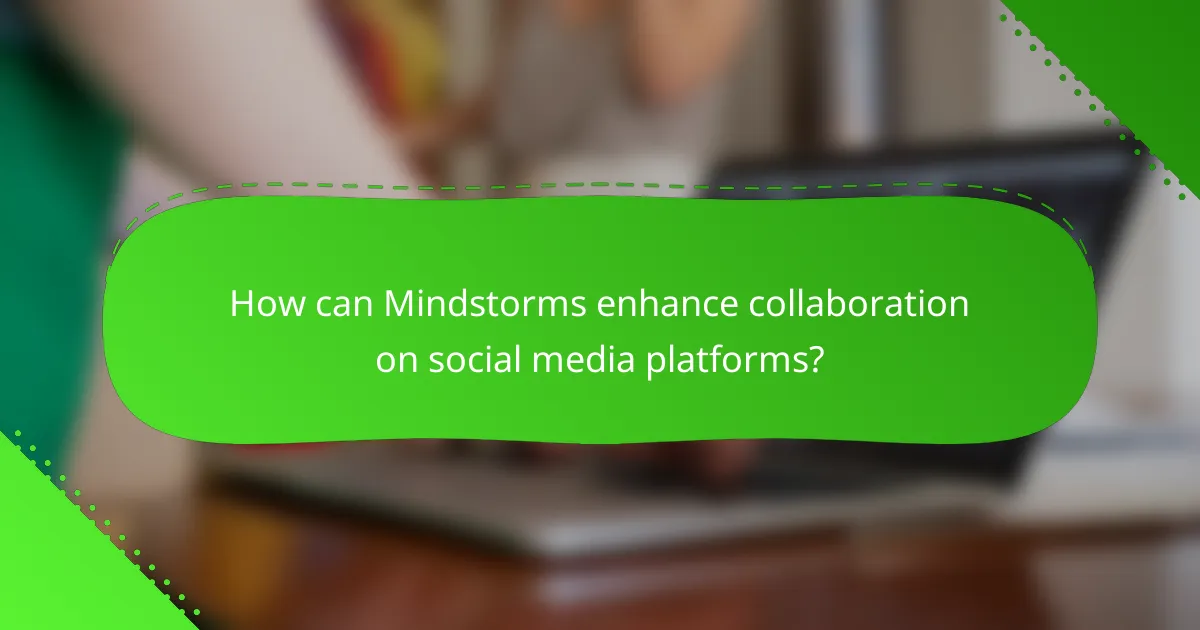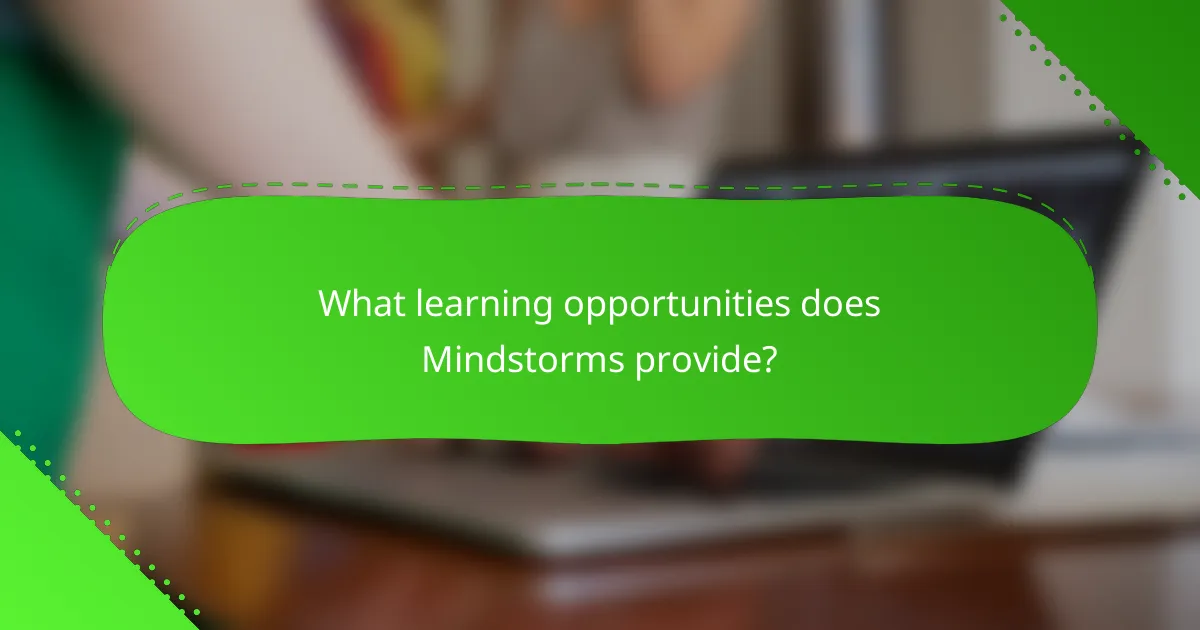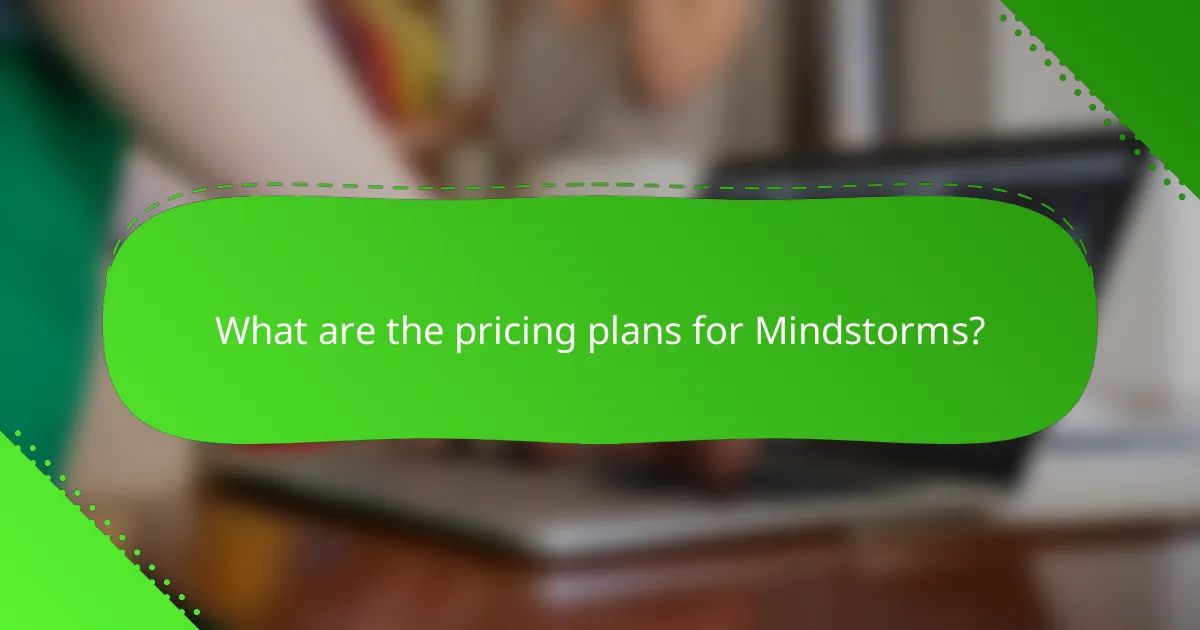Mindstorms plays a pivotal role in enhancing collaboration on social media platforms by equipping users with tools that streamline communication and project sharing. By fostering a vibrant community of innovation, it offers diverse learning opportunities in robotics, programming, and engineering, allowing participants to engage in hands-on experiences. Additionally, Mindstorms facilitates networking through community forums and events, enabling users to connect with peers and industry experts to expand their knowledge and build valuable relationships.

How can Mindstorms enhance collaboration on social media platforms?
Mindstorms can significantly enhance collaboration on social media platforms by providing tools and resources that facilitate communication and project sharing among users. These platforms enable users to connect, share ideas, and collaborate on projects in real-time, fostering a community of innovation and learning.
Integration with Facebook Groups
Integrating Mindstorms with Facebook Groups allows users to create dedicated spaces for discussion and collaboration. Members can share project updates, ask questions, and provide feedback, which enhances the learning experience.
To maximize this integration, consider creating specific groups for different projects or themes. This organization helps keep discussions focused and relevant, making it easier for members to find information and contribute effectively.
Utilization of Twitter for real-time updates
Twitter serves as an excellent platform for sharing real-time updates related to Mindstorms projects. Users can post quick updates, share links to resources, and engage in conversations with followers, keeping the community informed and connected.
To leverage Twitter effectively, use relevant hashtags and tag other users or organizations involved in your projects. This practice increases visibility and encourages broader participation in discussions.
Collaboration through LinkedIn networking
LinkedIn offers a professional environment for Mindstorms users to network and collaborate on projects. By connecting with industry professionals and educators, users can share insights, seek mentorship, and explore potential partnerships.
To enhance collaboration on LinkedIn, join relevant groups and participate in discussions. Sharing articles, project outcomes, and learning experiences can attract like-minded professionals and expand your network significantly.

What learning opportunities does Mindstorms provide?
Mindstorms offers a variety of learning opportunities that enhance skills in robotics, programming, and engineering. Participants can engage in hands-on experiences that foster creativity and problem-solving abilities through structured activities and resources.
Online workshops and webinars
Mindstorms hosts online workshops and webinars that cater to different skill levels, from beginners to advanced users. These sessions typically cover essential topics such as programming techniques, design principles, and project management. Participants can interact with experts, ask questions, and gain insights into best practices.
To make the most of these workshops, consider attending live sessions for real-time interaction or accessing recorded versions for flexible learning. Check the schedule regularly, as new topics are often introduced based on community interest.
Access to tutorials and resources
Mindstorms provides extensive access to tutorials and resources that guide users through various projects and concepts. These materials include step-by-step guides, video demonstrations, and downloadable content that can be used for self-paced learning. Resources are often categorized by difficulty level and project type, making it easier to find suitable content.
Utilizing these resources can significantly enhance your understanding of robotics. Be sure to explore community forums and user-generated content for additional insights and tips from fellow learners.
Partnerships with educational institutions
Mindstorms collaborates with educational institutions to integrate robotics into curricula, providing students with hands-on learning experiences. These partnerships often result in workshops, competitions, and special events that encourage teamwork and innovation among students.
Schools and universities can benefit from these partnerships by accessing tailored programs that align with educational standards. If you are an educator, consider reaching out to local Mindstorms representatives to explore potential collaborations that can enrich your students’ learning journey.

How does Mindstorms facilitate networking?
Mindstorms enhances networking by providing various platforms for users to connect, share ideas, and collaborate. Through community forums, networking events, and opportunities to engage with industry experts, participants can build valuable relationships and expand their knowledge base.
Community forums for peer interaction
Community forums serve as a vital space for peer interaction, allowing users to discuss projects, share challenges, and seek advice. These forums often feature threads on specific topics, enabling focused conversations that can lead to innovative solutions.
Active participation in these forums can help users establish their presence in the Mindstorms community. Regularly contributing to discussions or sharing insights can attract like-minded individuals and foster collaborative opportunities.
Networking events and meetups
Networking events and meetups are organized to bring together Mindstorms enthusiasts, providing a platform for face-to-face interactions. These gatherings can range from local meetups to larger conferences, often featuring workshops, presentations, and hands-on activities.
Attending these events allows participants to connect with others who share similar interests and goals. It’s beneficial to prepare by researching attendees or speakers in advance, which can facilitate meaningful conversations and potential collaborations.
Collaboration with industry experts
Collaboration with industry experts is a key aspect of the Mindstorms networking experience. Users can often find opportunities to work alongside professionals who have extensive knowledge and experience in robotics and technology.
Engaging with these experts can provide insights into best practices and emerging trends. Users should leverage social media platforms or professional networks to reach out and establish connections, as many experts are open to mentoring or collaborating on projects.

What are the best practices for using Mindstorms in social media?
To effectively use Mindstorms in social media, focus on creating engaging content, leveraging analytics for improvement, and building a consistent brand presence. These practices will enhance your reach and foster a community around your projects.
Creating engaging content
Engaging content is crucial for capturing attention on social media platforms. Use high-quality images and videos of your Mindstorms projects to showcase their functionality and creativity. Incorporate storytelling elements to connect with your audience emotionally.
Consider using polls, quizzes, or challenges related to Mindstorms to encourage interaction. Regularly update your content to keep your audience interested and informed about new developments or features.
Leveraging analytics for improvement
Utilizing analytics tools can significantly enhance your social media strategy. Track metrics such as engagement rates, reach, and follower growth to understand what content resonates with your audience. Platforms like Facebook and Instagram offer built-in analytics that can guide your content decisions.
Regularly review your analytics to identify trends and adjust your strategy accordingly. For example, if videos receive higher engagement than images, prioritize video content in your future posts.
Building a consistent brand presence
Consistency in branding helps establish recognition and trust among your audience. Use the same logo, color scheme, and tone across all social media platforms to create a cohesive identity. This uniformity makes it easier for followers to identify your content.
Engage with your audience regularly by responding to comments and messages. This interaction not only builds community but also reinforces your brand’s presence in the Mindstorms space. Aim for a posting schedule that keeps your audience engaged without overwhelming them.

What criteria should be considered when choosing a social media platform?
When selecting a social media platform, consider factors such as your target audience, platform features, and how well it integrates with Mindstorms. These criteria will help ensure that the platform effectively supports your collaboration and learning goals.
Target audience demographics
Understanding the demographics of your target audience is crucial when choosing a social media platform. Different platforms attract varying age groups, interests, and professional backgrounds. For instance, LinkedIn is popular among professionals, while Instagram tends to attract a younger audience.
Analyze where your audience spends their time online. Tools like Google Analytics or social media insights can provide valuable data on user demographics, helping you select a platform that aligns with your audience’s preferences.
Platform features and tools
Each social media platform offers unique features and tools that can enhance collaboration and learning. For example, Facebook provides groups and events, while Twitter excels in real-time updates and discussions. Evaluate which features are most relevant to your Mindstorms projects.
Consider the ease of use and accessibility of these tools. A platform with intuitive navigation and robust support resources can facilitate smoother interactions and learning experiences for all participants.
Integration capabilities with Mindstorms
Integration capabilities are essential when choosing a social media platform for Mindstorms collaboration. Look for platforms that can seamlessly connect with Mindstorms software and hardware, allowing for easy sharing of projects and ideas. For instance, platforms that support file sharing and API integrations can enhance collaboration.
Assess the compatibility of the platform with existing tools and workflows. Ensuring that the platform can work alongside Mindstorms will streamline communication and project management, making it easier for users to collaborate effectively.

What are the pricing plans for Mindstorms?
Mindstorms offers various pricing plans to accommodate different user needs, ranging from free trials to enterprise solutions. Each plan is designed to provide flexibility for individuals, small teams, and larger organizations, ensuring access to essential features and support.
Free trial options
Mindstorms provides a free trial option that allows users to explore the platform without any financial commitment. This trial typically lasts for a limited period, often around 14 to 30 days, giving users ample time to evaluate the features and functionalities.
During the trial, users can access most of the core features, enabling them to assess how well Mindstorms meets their collaboration and learning needs. It’s advisable to take full advantage of this period to test integrations and user experience.
Monthly subscription details
The monthly subscription for Mindstorms is designed for individuals and small teams who prefer flexibility. Pricing generally starts at a moderate rate, allowing users to pay on a month-to-month basis without long-term commitments.
Subscribers benefit from regular updates and customer support. It’s important to review the specific features included in the monthly plan, as some advanced functionalities may require an upgrade to a higher tier.
Enterprise pricing for large teams
For larger organizations, Mindstorms offers enterprise pricing tailored to the specific needs of big teams. This pricing model typically includes bulk discounts and additional features such as enhanced security, dedicated support, and custom integrations.
Organizations interested in enterprise solutions should contact Mindstorms directly for a personalized quote. This approach ensures that the pricing reflects the scale of usage and any unique requirements the organization may have.
